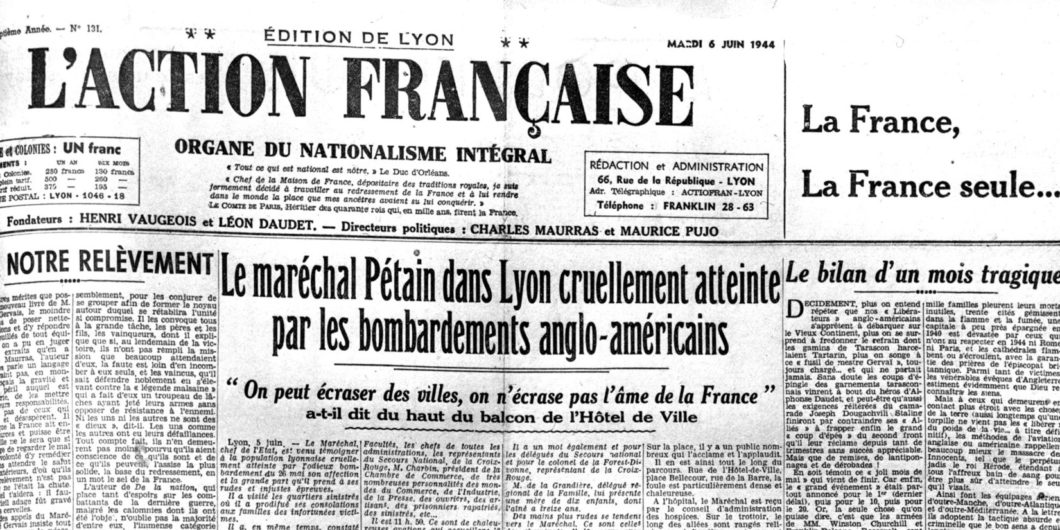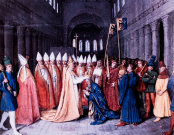Clarifying the relationship between liberal democracy and Catholicism in America for those whose history doesn’t go further back than the 1980s.
How Not to Challenge the Integralists
Professor Patterson’s recent Law & Liberty tour-de-force shifts the discussion about Catholic integralism to the question of why integralism has gained any purchase in America. His answer is that out of aesthetic nostalgia, “mostly young men” play with integralist ideas, imitate the attacks the mid-20th century European right made on republican virtue, and so play with the fire of fascism. To justify the connection between integralism and fascism, Patterson makes two claims that structure the bulk of his essay.
The first of these is that “in the case of integralism, its connection to fascism is undeniable.” His second major claim is that, “Integralism emerged during the years in between the First and Second World Wars in majority Catholic countries.”
I admire Patterson for raising the question of why integralism, whose political proposals verge on the fantastic, has gained any purchase in America. Yet Patterson’s essay fails to deliver on its promise. Instead of providing the historical and cultural discussion we need, he falls into jejune accusations of fascism. If we are going to provide sound, critical responses to the old European right’s incursions into the United States—which we should—it is as important to provide an accurate historical and conceptual account as it is to avoid deceptive polemics. On these points, I shall show where Patterson’s essay goes astray, and how it inadvertently ends up confirming the charges of liberalism’s contemporary critics.
A Primer on the Origins of Catholic Integralism
In contending that integralism “emerged during the years in between the First and Second World Wars,” Patterson casts its 19th century origins aside. This account reduces integralism to the decisions made amidst the political and economic turmoil of the 1930s and 40s, and so distorts what integralism was for.
Although its theological claims go back further, Catholic integralism owes its politics to post-revolutionary Europe. The basic presupposition of integralism is that theology is prior to politics and must order politics. As Émile Perreau-Saussine observed in Catholicism and Democracy, this requires a strong demarcation between the spiritual power of the Church and the temporal power of the state. That demarcation was not visible in the Ancien Régime, as the monarch anointed at Reims mixed temporal and spiritual power. The cruel exposure of that demarcation came as the French Revolution’s newly secular state violently attempted to assert its temporal power over the spiritual power of the Church. Since Catholics could no longer rely on their monarch—a Christian head of a Christian state—to protect the Church’s liberties, early 19th century Catholic political thinkers sought a deeper understanding of the principles of authority. They looked to the Papacy—to spiritual power—as the ultimate guarantor of Catholic liberties. Hence Perreau-Saussine argues that integralism is post-revolutionary. Ultramontanist thinkers, such as Joseph de Maistre, helped develop the demarcation between Church and State. In distinguishing temporal authority from spiritual authority, spurning Bonapartist Concordats to revive the Gallican Church, and granting that the Pope was the ultimate authority, these thinkers sought to free the Church from the grip of the post-Revolutionary secular state and campaigned for regimes that would get the Church-State relationship right.
In short, the sine qua non for integralism was the primacy of theology and spiritual power vis-à-vis temporal power. The conditio per quam was a temporal power that would accept the primacy of the spiritual power.
Connecting Fascism with Integralism is a Historical Mistake
Without this contextual compass, Patterson cannot navigate the mid-20th century to reach his desired destination, demonstrating that “in the case of integralism, its connection to fascism is undeniable.” He is shipwrecked upon two errors.
First, he constructs a false continuum between integralist movements, non-liberal but non-fascist political movements, and fascist movements. This continuum ignores important refusals to collaborate with fascism. Second, Patterson imagines unified integralist movements over the very period when unity collapsed, as the prospects for a temporal power that would accept the primacy of the spiritual power became more and more distant. What this fragmentation produced amongst former integralists was an ideologically diverse range of positions that belies any alleged link between integralism and fascism.
To showcase these two errors, let us have a closer look at two movements Patterson calls integralist and accuses of complicity with fascism: Action française and Spain’s Carlists.
Patterson singles out Action française and its leader Charles Maurras to make the link between integralism and fascism. But Maurras was plainly not an integralist. His doctrine was integral nationalism. Patterson mistranslates Maurras’s slogan nationalisme intégral as “National Integralism,” and so gets Maurras backwards. At the height of his influence (before, not after, the First World War), Maurras drew many Catholics to him, but not just Catholics. As the proper translation of his doctrine suggests, Maurras sought to synthesise the Revolutionary-era doctrine of nationalism with a right understanding of government, which was operationally similar to the liberal July Monarchy. Maurras’s stance toward Catholicism was the subject of legendary controversy because he was a pronounced agnostic. Moreover, influenced by Comte’s positivism, he discussed the Catholic Church through a socio-political lens, as an ineliminable part of France’s history and society and a positive force for order.
Unlike integralism, then, Maurras placed politics prior to theology. This prioritisation, as well as some of his anti-clerical early writings, exposed Maurras to the charge that he was instrumentalising the Church to the nationalist project. He was therefore excommunicated in 1926. Maurras defended himself with quasi-liberal arguments: he could accept Church authority over faith and morals, matters of religion, but the Church had no authority over politics. Jacques Maritain, who had supported Maurras until the excommunication, was much more of an integralist—he held to the primacy of theology over politics his whole life. Once Rome spoke against Maurras, he obeyed Rome. Certainly, Maritain’s innovation on integralism was to argue that the truest integralism was integral humanism. In this way, he challenged supporters of the old integralism and Maurrassisme in turn.
Nor is it right to think that Maurras was a fascist. Maurras wanted a strong state, which he thought was only possible with a monarchy. But he also wanted state power confined to its proper spheres. He deplored the sweeping centralisation of the Jacobin republican state and was a federalist who championed France’s cultural, historical, linguistic, and regional diversity. As French historian Martin Motte has argued, Maurras criticised the fascist totalising state in defence of civil society. Maurras opposed Hitler, strongly denounced his racist philosophy and his “antisémitisme de peau,” and urged French rearmament. Of course we could write a whole essay on what Maurras gets wrong. He traded in popular anti-Semitic tropes and imprudently supported Vichy because he thought it was the best way to rebuild France to win the next round of combat against the Germans.
Yet by that time, Maurras was no longer leading a unified movement. The excommunication splintered Action française. Moreover, when Maurras endorsed Franco in 1936, that was too much for another Catholic who held to the integralist primacy of theology over politics, Georges Bernanos. Many of Maurras’s intellectual and political fellow-travellers joined the Resistance. Certainly there were also those who supported Action française who ended up supporting Vichy, and—not the same thing—ended up supporting fascism. But we could just as well point out the myriad of figures involved with Action française (and other nationalist or corporatist continental movements) who later on sided not with the far-right but with far-left; in the Catholic world, the “red” Dominicans and worker priests were first schooled in Maurras’s royalism.
When Patterson speaks of Spain’s Carlists, he at least refers to a genuine integralist movement. But it became prominent in the 1830s, almost a century before fascism came on the scene; the 19th century demonstrated its intransigence on doctrinal and political manners and its refusal to compromise with a liberal monarchy. It is true that Carlists sided with Franco in 1936. Siding with Franco, however, did not indicate ideological conformity to Franco’s party, let alone within Franco’s party. Franco’s supporters were composed of diverse ideological factions that often brawled with each other: those sympathetic to versions of the monarchy, from liberal to integralist manifestations; those sympathetic to republicanism but disgusted by the current manifestation of it; those sympathetic to direct military rule, and those sympathetic to the Falange fascist party.
The Carlist leader, Manuel Fal Conde, despised the Falangists and resisted efforts to combine his movement with them. He found his organisation fracturing in 1936 as the military dispersed the Carlist militia throughout Nationalist territory. Despite some Carlist appointees to Franco’s government (whom other Carlists frequently denounced for collaboration), the Carlist movement remained a marginal presence in Franco’s Spain. Several times Franco even expelled Don Javier, the Carlist claimant to the throne, from Spain.
Patterson’s sweeping declaration that there was an “alliance between integralist Carlists and fascist Falangists in Spain” overlooks that while some Carlists agreed to support Franco, and some preferred outright opposition, the Carlists and Falangists remained enemies. Patterson’s declaration snubs the Carlists whom Falangists attacked and killed during and after Franco’s rule. Moreover, the Carlist movement steadily lost ideological coherence. Don Javier’s son, Carlos Hugo, led a following that admired Tito’s socialism. Fal, who had remained a prominent anti-Francoist, led the traditionalist and integralist following until his death in 1975.
Equating Fascism with Integralism is a Conceptual Mistake
The basic conceptual error underlying Patterson’s loose continuum between integralism, non-liberal movements like Action française, and fascism, is his failure to distinguish between revolutionary and counter-revolutionary political thought. To the extent there is alignment between the “primacy of theology” integralists and the “primacy of politics” Action française, it is on the fact that they both drew on the resources of counter-revolutionary thought to describe society.
From Edmund Burke onwards, counter-revolutionary thinkers held to a natural, organic conception of society. They identified the bodies or groups that had major social and political interests, held them to be a persistent part of the natural order, and sought to protect their freedoms. This developed into the corporatist proposals to give those bodies formal political representation.
Granting representation to distinct groups in the social order did not interest the fascists. Using their political party, fascists aimed to seize control of the state and reconfigure the entire social order, with the party commanding all of social and political life. This three-fold emphasis on the party, totalising state, and rapid social re-arrangement finds no common ground with counter-revolutionary thought. Fascism, as François Furet understood, is a revolutionary movement, and it arose as a response to the most powerful revolutionary movement of the day, Communism.
Because they were attentive to the difference between counter-revolution and revolution, Furet, René Rémond, and Raymond Aron all held that it was a mistake to label Action française as a fascist movement. Rémond, moreover, regards integralism as a case study in the persistence of counter-revolutionary ideas into the mid-20th century.
Anti-Republicanism in the European Context
What scandalises Patterson is the European critique of republicanism, which he thinks leads to a position that makes republican virtues—“the capacity for compromise, for goodwill, and for a belief that our representative government ought to translate our passions into public reason”—an enemy of the state. This buttresses up his charge of authoritarianism.
But we can see how this conclusion about European anti-republicanism is misguided if we take a closer look at Patterson’s bogeyman, Charles Maurras. In the European context, anti-republicanism was not an attack on virtue but on ineffective and impotent government. One of the most vexing political questions raised by the French Revolution in 1789 was how the legislative branch would relate to the old monarchical executive. From 1789-1793, the legislative usurped the executive’s power, and that usurpation became definitive of the continental republican political tradition. It exalted the mystique of the legislative as the true embodiment of national sovereignty and kept executives weak for fear of their inherently monarchical, Bonapartist, or Caesarist impulses. However, republican parliamentarism produced notorious revolving-door governments with unstable executives.
In criticising republicanism, Maurras aspired for a stronger government. But rejecting Caesarist or Bonapartist dictatorship, he wanted government powers restricted to matters of national unity and foreign policy. Maurras was a critic of how excessive republican parliamentarism made national defence policy incoherent, weakening France in the face of its adversaries. Maurras also drew attention to how republican parliamentarism, when combined with the multi-party system, weakened virtue. Parties did not represent the national interest but narrow group interests. Eschewing the capacity for compromise and goodwill, these parties intensified factionalism and division. Instead of building representative government that translated passions into public reason, France got representative government that in Maurras’s words produced “economic, moral, social, and religious dissolution.” The electorate became debased through entitlement politics, where its pitiful cry to the party machine became: “I vote for you, now feed me.”
Maurras defended parliamentarism in its proper context: his would be an “even parliamentary” regime, because it trusted local and provincial organisations to have functioning deliberative assemblies. To paraphrase Patterson, Maurras defended the liberty to form civic associations to serve the common good, holding that that rendered the state superfluous in most cases. Ordinary Frenchmen could handle their own affairs, leaving the state more capable in the areas where government action was most vital. Far from attacking virtue, Maurras argued that the only way to achieve the (republican) virtues of a patriotic, and self-governing citizenry was to discard the Republic.
In founding the Fifth Republic, this is basically what de Gaulle—who read Maurras—did. Without falling into Caesarism, de Gaulle weakened the legislative branch and strengthened the executive branch, altering the meaning of French republicanism. In the American idiom we could say that Maurras sought the Hamiltonian via media of a unitary executive, criticising the Imperial Presidency and the Imperial Congress.
Patterson’s Latent Polemic: An Appeal to Western Marxism
Patterson’s argument culminates with psychological speculation. Integralism, he writes, is “an internet aesthetic of mostly young men alienated from the public life and consumed with the libido dominandi.” The words may be Augustinian, but the substance of the argument is Adorno on the ‘authoritarian personality’ and Marcuse on how aesthetics furthers the desire for domination. Together, these arguments serve the function of drastically expanding the “fascist” label. As Adorno and Marcuse intended, this new definition of fascism delegitimises any discussion about proper authority and order, favouring the libertinism of the far left.
The essential problem with Patterson’s essay is not its wobbly history. The essential problem is that he relies on Adorno’s and Marcuse’s anti-fascist agitprop to win the argument. The “young men,” whatever their other flaws, are smart enough to recognise this. They spot that many liberal arguments essentially rely on this fascist vs. anti-fascist dichotomy—not as defined through study of history, but as defined and promulgated by the ideological gurus of Western Marxism. In these cases, it is easy to see why Carl Schmitt’s critique of liberalism becomes attractive, since Schmitt’s critique is in part about exposing liberalism’s underlying reliance on polemical, ideological concepts, despite its claims to the contrary. Patterson’s response affirms what liberalism’s Schmittian critics contend.
A better response would imitate Leo Strauss’s “Notes on Carl Schmitt.” It should demand a better account of the order of the human things, not through polemics but by a return to the study of nature—particularly the nature of the good. When thinkers come up who are not part of the American conservative or liberal canon, we should proceed with non-polemical inquiry, which does not presuppose but seeks the “pure and whole knowledge” that these thinkers could provide.


